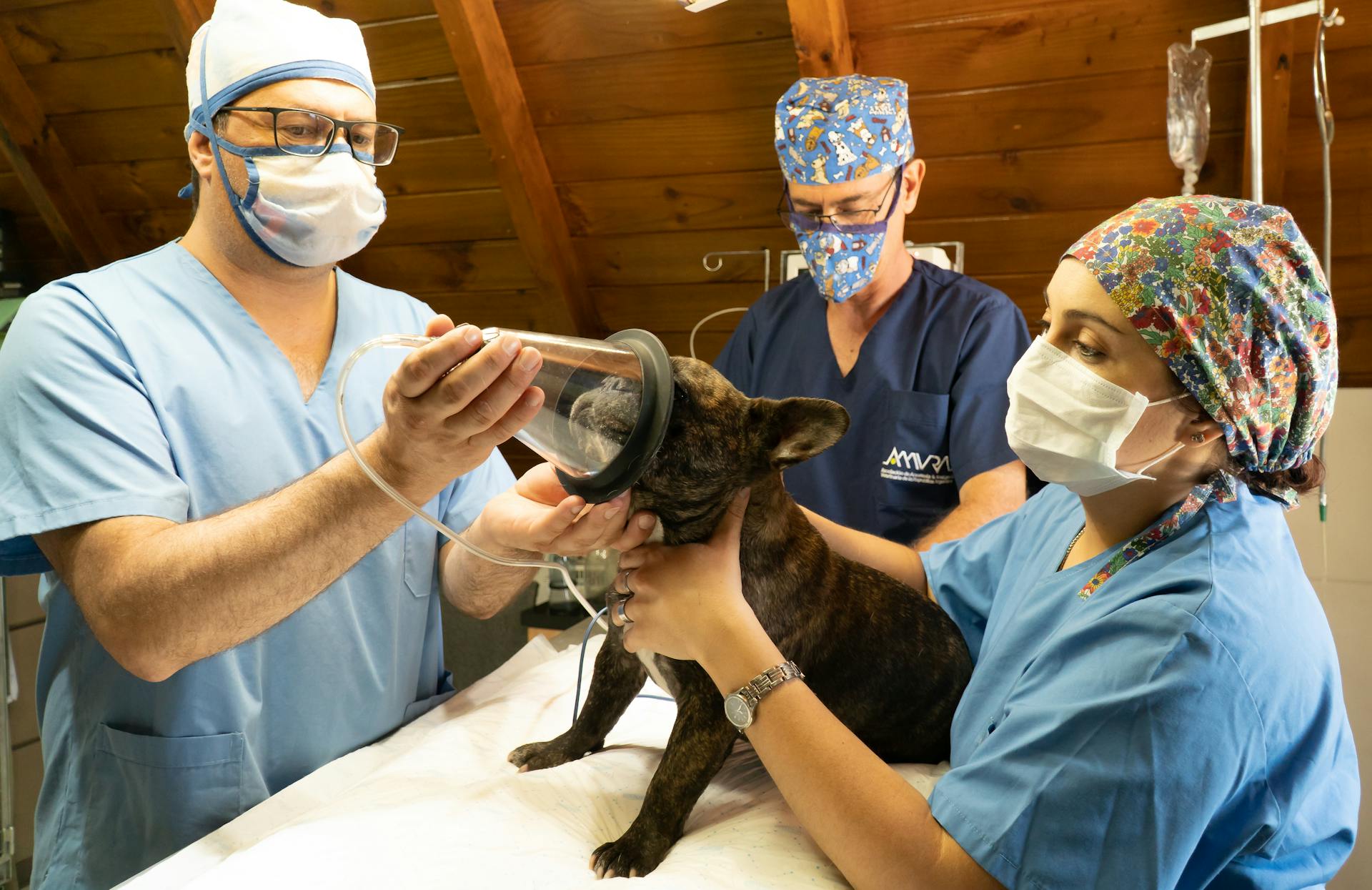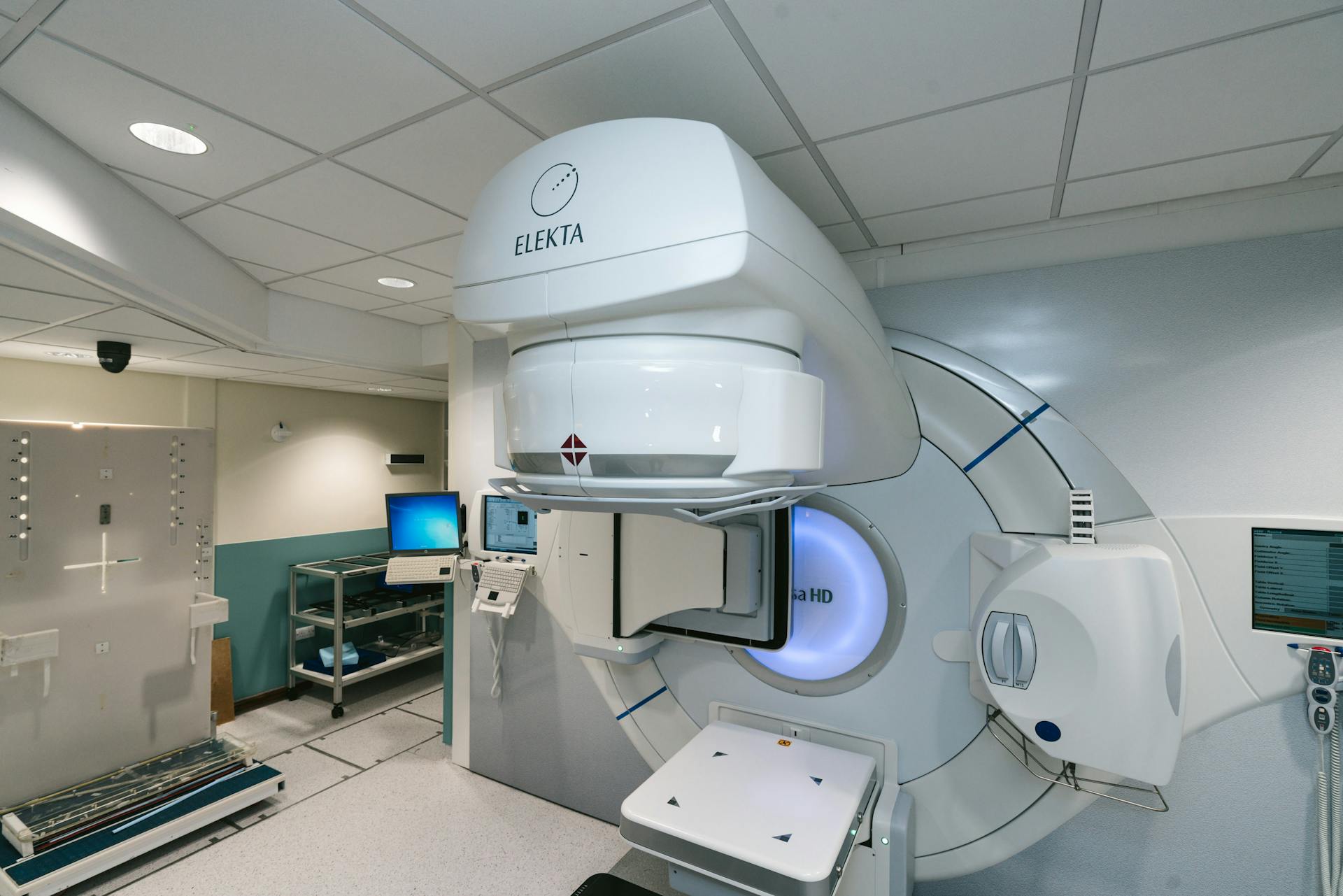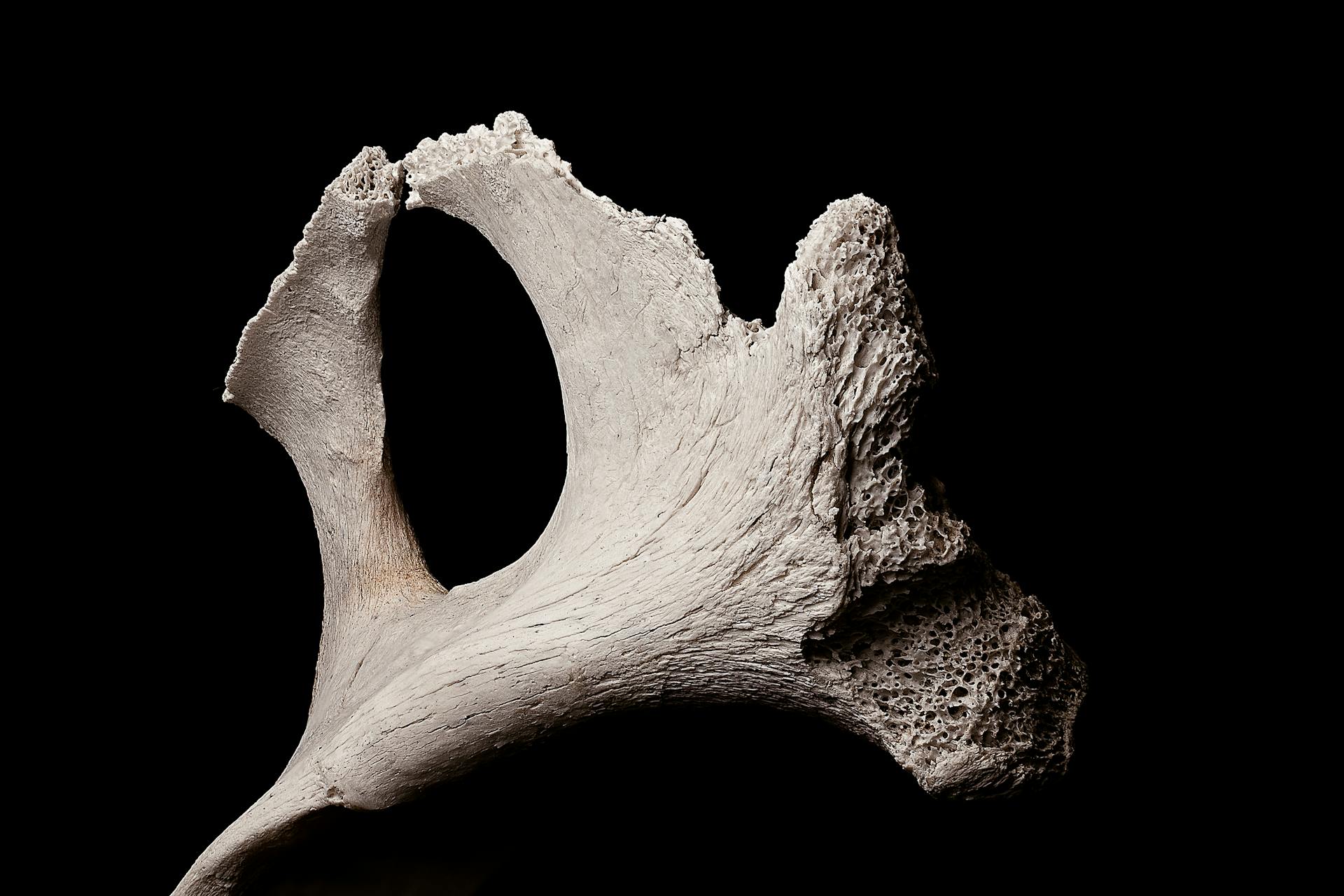
Canine bone cancer is a serious diagnosis that requires careful consideration of treatment options. Surgery is often the primary treatment for osteosarcoma, the most common type of canine bone cancer, and can involve amputation of the affected limb.
The goal of surgery is to remove the tumor and any affected bone, while preserving as much of the surrounding tissue as possible. The type of surgery performed will depend on the location and size of the tumor.
Chemotherapy is often used in conjunction with surgery to help prevent the cancer from spreading to other parts of the body. This can be administered before surgery to reduce the size of the tumor, or after surgery to target any remaining cancer cells.
Radiation therapy may also be used to help control the growth of the tumor and alleviate symptoms such as pain. However, its effectiveness can vary depending on the type of bone cancer and the individual dog's response.
On a similar theme: Mast Cell Tumor in Pit Bulls
Causes and Types of Canine Bone Cancer
Canine bone cancer is a complex and multifaceted issue, and understanding its causes and types is crucial for pet owners and veterinarians alike.
Most tumors and cancers, including canine bone cancer, have a complex mix of risk factors, some environmental and some genetic or hereditary.
Osteosarcomas, a type of bone cancer, appear to affect large breed dogs more commonly than small breeds, with reported predisposed breeds including Boxer Dogs, Doberman Pinschers, Golden Retrievers, German Shepherd Dogs, Great Danes, Greyhounds, Irish Setters, Irish Wolfhounds, and Rottweilers.
Genetics play a large role in the development of osteosarcoma, especially in large and giant breeds, with researchers identifying genetic risk factors in breeds like Scottish Deerhounds, Rottweilers, Greyhounds, and Irish Wolfhounds.
Osteosarcoma can also develop at previous trauma sites in bone, such as radiation therapy sites, previously healed fractures, and chronic osteomyelitis (bone infection).
Here is a list of breeds that are predisposed to osteosarcoma:
- Boxer Dogs
- Doberman Pinschers
- Golden Retrievers
- German Shepherd Dogs
- Great Danes
- Greyhounds
- Irish Setters
- Irish Wolfhounds
- Rottweilers
Osteosarcoma most often appears in middle-aged dogs, between 6 and 10 years old, but it has also been reported in 1-2 year old dogs.
Some Common Symptoms Include:
Swelling in the ribs, spine, legs, or jaw is often one of the first signs of bone cancer in dogs.
Severe pain is a common symptom of osteosarcoma in dogs, and it can be caused by the tumor on the bone.
A mass or lump on the dog's body is another possible symptom, and it's often accompanied by a loss of appetite.
Limping or lameness is a classic sign of bone cancer in dogs, especially when it affects the limbs.
Respiratory distress can occur if the tumor is located near the lungs or chest.
Discharge from the nostrils can be a symptom of osteosarcoma, especially if the tumor is located in the jaw or facial bones.
Lethargy or weakness can be a sign of bone cancer in dogs, and it's often accompanied by a loss of appetite.
Here are some common symptoms of osteosarcoma in dogs:
- Swelling in the limbs, ribs, spine, or jaw
- Severe pain
- Mass or lump on the dog's body
- Loss of appetite
- Limping or lameness
- Respiratory distress
- Discharge from the nostrils
- Lethargy or weakness
Diagnosis
Diagnosis of canine bone cancer typically begins with a physical exam and X-rays of the affected limb. X-rays can reveal classic signs of osteosarcoma, such as lytic lesions, productive bone growth, and a "sunburst" pattern.
Veterinarians may also suspect osteosarcoma based on age, breed, and clinical signs alone. In some cases, a veterinarian may already suspect osteosarcoma before taking X-rays.
To confirm the diagnosis, a veterinarian may perform a fine needle aspiration or biopsy, which involves taking a sample of cells or tissue from the lesion. A veterinary pathologist then examines the sample under a microscope to confirm the diagnosis.
A definitive diagnosis of osteosarcoma requires a biopsy, which is considered the gold standard for diagnosis. The biopsy is typically performed under sedation and involves taking a large sample from the core of the lesion.
Diagnostic tests may also include blood work, abdominal ultrasonography, and advanced imaging, such as CT, MRI, and bone scans, to evaluate the extent of local and distant cancer spread.
How Veterinarians Diagnose
Veterinarians use radiographs (X-rays) as the most useful diagnostic tool for osteosarcoma in dogs. They need at least two radiographic views of the affected limb to look for classic signs of osteosarcoma.
Lytic lesions, which appear moth-eaten due to bone loss or destruction, are a common sign of osteosarcoma. Productive bone growth and a "sunburst" pattern are also indicative of this disease.
Soft tissue swelling around the lesion and pathologic fractures are other signs that veterinarians look for. Osteosarcoma typically forms in the long bones surrounding the knee in the hind legs and away from the elbow in the front legs.
To confirm the diagnosis, veterinarians may perform additional diagnostic procedures. Cytology, a relatively noninvasive procedure, involves using a small needle to obtain a sample of cells from the lesion. However, it may not get a diagnostic sample in the center of the mass.
Biopsy is the gold standard for diagnosis of osteosarcoma. It involves obtaining a large sample from the core of the lesion, which is then reviewed by a veterinary pathologist to confirm the diagnosis.
Other diagnostic procedures include routine blood work, abdominal ultrasonography, and three-view chest radiographs. These tests help identify organ function, detect distant metastasis, and determine cardiac function in dogs with suspected heart disease.
Here are the diagnostic procedures that veterinarians may recommend:
- Cytology of the area
- Biopsy
- Routine blood work
- Abdominal ultrasonography
- Three-view chest radiographs
- Echocardiography
- Advanced imaging (CT, MRI, and bone scans)
Typical Progression

Osteosarcoma in dogs is extremely aggressive.
At the time of diagnosis, about 90-95% of dogs will have micrometastasis, meaning the cancer cells have already spread elsewhere even though they are not detectable.
Staging is always recommended in dogs with osteosarcoma, which may include bloodwork, urinalysis, X-rays of the lungs, and possibly an abdominal ultrasound, CT or MRI.
If any lymph nodes are enlarged or feel abnormal, further sampling may be pursued to determine if spread is present.
Readers also liked: How Fast Does Lymphoma Spread in Dogs
Treatment Options
Treatment options for canine bone cancer depend on the results of diagnostics performed. In cases of infection, systemic therapy including antibiotics, antifungal, or antiviral agents may provide sufficient therapy.
Painful bone lesions still require amputation or surgical removal. For metastatic tumors, the nature of the primary tumor will guide further therapy.
Several factors are considered when determining therapy for primary bone tumors, including the dog's physical condition, potential for spread of disease, prognostic factors, and the family's goals for quality of life. Treatment for osteosarcoma typically involves surgical management, chemotherapy, and immunotherapy options.
Here are some common treatment options for osteosarcoma:
- Surgical management: removal of the primary bone tumor by amputating the entire limb
- Chemotherapy: use of systemic chemotherapeutic agents such as cisplatin or carboplatin
- Immunotherapy: using the body's own immune system to help treat neoplastic cells
What Options Exist?

Treatment options for dogs with osteosarcoma vary depending on the extent of the disease and the dog's overall health.
Surgical management is a common approach, often involving amputation of the affected limb, which is usually well-tolerated by dogs.
Chemotherapy can significantly prolong survival time after diagnosis, with platinum-based agents like cisplatin and carboplatin being the standards of care.
Immunotherapy is a developing field that uses the dog's own immune system to help combat cancer cells.
Palliative options are available for dogs that are not candidates for surgery or chemotherapy, aiming to alleviate pain and potentially increase survival time.
These treatments include oral medications, IV bone supportive medications like bisphosphonates, and radiation therapy to provide pain relief.
If surgery or chemotherapy is not an option, veterinary surgeons may use debulking procedures or limb-sparing surgeries to remove as much of the tumor as possible.
Here are some examples of experimental treatments that have been studied:
Unfortunately, some of these experimental treatments have shown no significant improvement in treatment efficacy or survival time.
Treatment

Treatment options for dogs with osteosarcoma depend on the results of diagnostics performed, including the extent of disease and the dog's physical condition.
Systemic therapy, such as antibiotics, antifungals, or antivirals, may be used to treat infections, while painful bone lesions may require amputation or surgical removal.
For metastatic tumors, therapy is guided by the nature of the primary tumor, and several factors are considered when determining therapy for primary bone tumors, including the dog's physical condition, potential for disease spread, and prognostic factors.
Palliative options, such as oral medications and bisphosphonates, are available to alleviate pain and clinical signs in dogs with osteosarcoma.
Surgical management is a common consideration for appendicular osteosarcoma, and typically involves amputation of the affected limb or debulking procedures.
Chemotherapy is a standard of care for systemic chemotherapy in dogs with osteosarcoma, and typically involves platinum-based agents such as cisplatin or carboplatin, or doxorubicin.
Here is a summary of common chemotherapy agents used to treat osteosarcoma in dogs:
Palliative options, such as radiation therapy, may also provide pain relief and improve quality of life for dogs with osteosarcoma.
Management and Outlook
Dogs diagnosed with canine bone cancer can usually live for another 1-6 years with proper treatment.
The outlook for dogs with osteosarcoma is influenced by factors such as their age, weight, and the tumor's location, which only a veterinarian can accurately assess.
Your veterinarian or veterinary oncologist will develop a specialized treatment plan to help your dog achieve the best possible outcome, ensuring their comfort and quality of life for as long as possible.
Treatment options depend on the results of diagnostics, and may include surgery, systemic therapy, or a combination of both, depending on the extent of the disease and your dog's physical condition.
If this caught your attention, see: Canine Liver Cancer Treatment
Palliative Options
Palliative options are available for dogs and are directed at alleviating pain and clinical signs.
For dogs with bone cancer, oral medications can provide relief from pain and discomfort.
Some of these medications can be administered at home, making it easier to manage your dog's symptoms.
Readers also liked: Canine Cancer Pain Management
Oral medications can be an effective way to manage pain and other clinical signs associated with bone cancer.
IV bone supportive medications called bisphosphonates can also be administered to help alleviate pain and slow down bone damage.
Radiation therapy may provide pain relief and can be a course of treatment for some dogs.
It's a relief to know that there are options available to help make your dog's final days more comfortable.
Alternative
Alternative treatment options are available for dogs with primary bone tumors.
Lobaplatin is one such alternative chemotherapy protocol that has shown promising results.
In a study of 28 dogs with osteosarcoma, dogs treated with lobaplatin had a prolonged disease-free interval and survival time compared to historic controls treated with surgery alone.
Dogs were treated with surgical resection of the affected limb and adjuvant lobaplatin chemotherapy at a dose of 35 mg/m2 i.v. once every 3 weeks, for a maximum of 4 doses.
The results suggest that lobaplatin prolonged the disease-free interval and survival time in dogs with osteosarcoma.
Recommended read: Hemangiosarcoma in Dogs Survival Rate
Cancer Outlook
Dogs diagnosed and treated for bone cancer can usually live for another 1 - 6 years.

Your veterinarian or veterinary oncologist will develop a specialized treatment plan to help your dog achieve the best possible outcome.
Only your vet will be able to provide you with an accurate prognosis for your pet.
Unfortunately, bone cancer is extremely aggressive and often proves fatal even when treated with surgery and other therapies.
Recovery and Management
Amputation alone only provides short-term pain relief, and most dogs succumb to distant metastasis within months, with only 10% surviving for one year.
The combination of amputation and chemotherapy increases the survival time to approximately one year after diagnosis, with 20% of dogs surviving longer than two years.
Veterinarians require regular check-ups, including physical exams, blood work, and chest radiographs every 2-3 months to monitor for metastasis and complications.
Dogs without any treatment, medical or surgical, have an expected survival time similar to amputation only, around 4 months, and suffer from severe pain and pathologic fractures.
If this caught your attention, see: T Cell Lymphoma in Dogs Life Expectancy
When to Seek Veterinary Care
If your dog is displaying symptoms of bone cancer, call your vet immediately to book an emergency appointment.
Urgent treatment is required because bone cancer is an aggressive disease that has a tendency to spread extremely quickly.
Symptoms to look out for include those mentioned earlier, and pet parents should always take them very seriously.
Osteosarcoma can quickly become fatal if not detected early enough to treat.
Radiotherapy
Radiotherapy is a palliative method of treatment for canine bone cancer, aiming to provide pain relief and prolong patients' lives.
This approach is not easily accessible and requires a general anesthesia of the patient.
Studies have shown that combined therapy, including surgery, chemotherapy, and radiotherapy, is the most effective way of treatment.
In one such study, 50 dogs were included, and median survival times were compared between those receiving palliative radiation therapy alone, and in combination with chemotherapy, pamidronate, or both.
The results showed that median survival times were the longest for dogs receiving radiotherapy together with chemotherapy, at 307 days.
In contrast, dogs receiving radiotherapy and pamidronate had the shortest median survival time, at 69 days.
Chemotherapy in addition to radiotherapy gave satisfying results, while enriching radiotherapy with pamidronate was ineffective.
Check this out: Natural Cures for Lymphoma in Dogs
Frequently Asked Questions
What does dog bone cancer look like?
Dog bone cancer, also known as osteosarcoma, typically presents with swelling and warmth in the affected area, and X-rays may show lytic or 'moth-eaten' bone lesions due to tissue loss
How long can a dog live with bone cancer?
Dogs with bone cancer typically live for 1-2 years, with some surviving up to 2 years or more with aggressive treatment. Survival rates vary, but treatment can significantly extend a dog's life
Is there a cure for bone cancer in dogs?
Unfortunately, there is no cure for bone cancer in dogs, but it can be effectively treated with surgery and other methods. Treatment typically involves removing the tumor or affected limb to manage the disease.
What can be mistaken for bone cancer in dogs?
Other conditions that can mimic the appearance of bone cancer in dogs include bacterial or fungal infections, bone injuries, and other types of tumors. A definitive diagnosis requires further testing and examination by a veterinarian.
Will an xray show bone cancer in dogs?
X-rays can help diagnose bone cancer in dogs, but a definitive diagnosis often requires further testing. If you suspect your dog has bone cancer, consult a veterinarian for a proper evaluation and treatment plan.
Sources
- https://vcahospitals.com/know-your-pet/osteosarcoma-in-dogs
- https://www.vravet.com/site/blog/2022/03/15/osteosarcoma-in-dogs-symptoms-and-treatment
- https://hospital.cvm.ncsu.edu/services/small-animals/cancer-oncology/oncology/bone-tumors/
- https://www.ncbi.nlm.nih.gov/pmc/articles/PMC4330401/
- https://www.petmd.com/dog/conditions/musculoskeletal/c_multi_osteosarcoma
Featured Images: pexels.com


